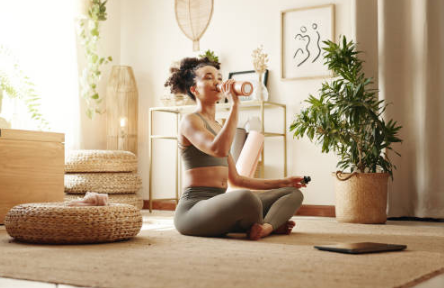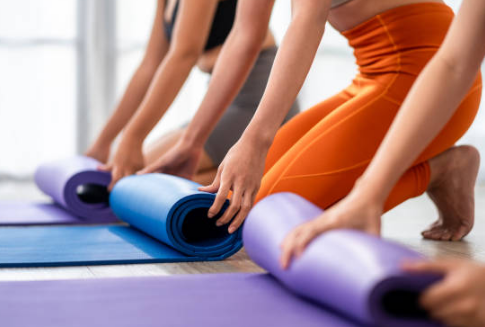According to Yoga Alliance, 28% of Americans had tried yoga at some point by 2016. That means a lot of people are at least familiar with the practice—or know someone who is. So, what are you waiting for? If you’ve never tried yoga before, now’s the perfect time to demystify it!
Yoga is a fantastic cross-training option that offers a triple benefit: it builds strength, improves flexibility, and strengthens your core—all with low-impact, adaptable intensity. That means almost anyone can do it. But to truly appreciate the power of yoga, you also have to consider its mental benefits.
The Benefits of Yoga
Yoga has a ton of proven health benefits—especially if you practice regularly. You might notice improved flexibility within just a few weeks of starting. It also helps improve muscle tone, strength, body awareness, and posture. Many foundational yoga poses encourage a straight spine and open shoulders. Beyond the physical perks, yoga also supports emotional wellness and nervous system health.

Yoga can also help with specific medical conditions. Research shows that yoga can significantly lower high blood pressure. It’s also been found to support heart health.
But yoga doesn’t just benefit the heart. A review of arthritis research found that yoga can help ease arthritis symptoms, particularly joint pain. In another small study, participants with carpal tunnel syndrome who practiced yoga twice a week for eight weeks reported less pain and stronger grip strength. If you have chronic lower back pain, practicing poses like downward dog for just a few weeks can help. Whether you’re managing a condition like arthritis or simply want to boost flexibility, yoga can make a difference. Of course, check with your doctor first to make sure it’s right for you.
Yoga’s impact goes beyond the physical. Studies show it’s also great for your brain and nervous system. One review found that yoga can reduce anxiety and depression. Other reviews show it can lower cortisol levels and ease the symptoms of stress. Even if you’re not dealing with mental health issues, yoga can still boost your mood and energy. Some poses are especially energizing or uplifting!
And even if you’re not looking to energize, yoga still benefits both mind and body. Whether it’s a meditative flow or a faster-paced class, yoga requires focus, mindfulness, and being present in the moment. Research shows yoga can offer the same benefits as meditation. The more you practice, the easier it becomes to concentrate and stay in the moment.
How to Get Started
Ready to jump in? Here’s a guide to the basics—from what to wear and bring, to how to find the right class and teacher.
What to Wear
Don’t let Instagram convince you that you need expensive matching sets to start yoga. For most yoga styles, your regular workout clothes are just fine. Look for comfortable, breathable clothes that fit well (cotton works great!).
-
Shoes: Most yoga is done barefoot on your mat. Leave your shoes at home or by the studio door. If going barefoot isn’t an option—because of injury or borrowed mats—consider yoga socks that help with grip and balance.
-
Pants/Shorts: No need to spend $100 on fancy yoga pants, especially as a beginner. Just wear stretchy, comfy leggings or shorts—whatever you already have. Many people prefer form-fitting clothes (like leggings) to stay balanced and covered during poses, but loose pants also work. Guys might wear compression shorts under looser pants. Avoid anything with a belt.
-
Tops: A fitted tee, tank top, or crop top is perfect—something that won’t ride up when you move. Moisture-wicking fabric is ideal, especially in heated classes. Some prefer tank tops to keep shoulders free, but long sleeves or wraps might be better in cooler rooms. For savasana (final resting pose), bring a light layer to stay warm.
-
Sports Bras: For women, a sports bra is a must. Even though yoga is low-impact, comfort and support matter. Choose one that’s comfortable—straps on regular bras can dig into your shoulders or spine when you lie down.
-
Hair and Accessories: Long hair should be tied back to avoid covering your face, especially in poses like headstands. Choose a style that’s comfortable when lying flat. If you’re doing hot yoga (like Bikram), a headband and yoga towel can be helpful. Avoid heavy jewelry—it can get in the way or be distracting.
What to Bring
Make sure to pack a few essentials for your first class.
-
Mat: A yoga mat is essential. Most studios offer them to borrow or rent (usually $1–$2), but if you’re planning to practice regularly, it’s worth investing in a quality mat. Look for something with good grip and cushioning, especially if you have knee issues or plan to practice on hard floors.
-
Towel: You’ll need a towel to wipe away sweat. Microfiber towels sized to match your mat are great, especially for hot yoga. You can also just bring a hand towel.
-
Water Bottle: A full hour of practice—especially hot yoga—requires hydration. Bring a leak-proof bottle and keep it near your mat.
Finding the Right Class and Teacher
With so many options, choosing your first class can feel overwhelming. Here’s how to narrow it down:
Step 1: Pick the Right Yoga Style for You
Fun fact: Yoga was originally taught in Sanskrit, so some pose names might sound unfamiliar. Each pose has an English and Sanskrit name (e.g., Tree Pose = Vrikshasana). You don’t need to learn Sanskrit, but two key words to know are:
-
Pranayama: Breathwork or breathing techniques
-
Asana: Physical yoga poses
While most people think of yoga as physical movement, breathing and mindfulness are equally important. Here’s a quick guide to common styles:
-
Hatha Yoga: Technically all yoga classes are “hatha,” but in the U.S., this label usually means a slower-paced, beginner-friendly class focused on basics.
-
Vinyasa Yoga: A faster-paced class that links breath to movement. Lots of Downward Dogs and flowing sequences!
-
Ashtanga/Power Yoga: High-energy, structured yoga that follows a set sequence. It’s great for building strength and stamina without lifting weights.
-
Iyengar Yoga: Focuses on alignment and uses props like blocks and straps to help you get into proper form.
-
Hot Yoga/Bikram: Done in a heated room (95–105°F) to loosen muscles and improve flexibility. Bikram follows 26 specific poses. Be ready to sweat, and talk to your doctor if you have any health concerns.
-
Restorative Yoga: A calm, relaxing class using props to help you gently stretch and relax. Great for all fitness levels, especially on recovery days.
There are plenty of other hybrid or specialty yoga classes too. Even if you’re already active, starting with a beginner class helps you learn the basics and build a strong foundation.
Step 2: Find the Right Teacher
Look for a certified yoga instructor—most complete a 200-hour training, but quality varies. Use the Yoga Alliance directory to search for qualified teachers near you. Ask friends for recommendations and try a few teachers until you find one whose style and personality you like.
Yoga Etiquette: What to Expect
Yoga has its own set of manners, different from other fitness classes. Here are a few tips for a great experience:
-
Arrive Early: Give yourself 5–10 minutes to check in, lay down your mat, and settle in. You can even set an intention or focus word for your practice. Don’t be the person rushing in after class starts.
-
Communicate with the Teacher: Let them know if you’re injured, new, or nervous. A good teacher will offer modifications and support.
-
Stay Quiet: Most people come to yoga to relax and unplug. Keep conversations outside the studio or speak softly. Silence your phone—and leave it outside the room if possible.
-
Be Respectful: Give others space for their mats, keep your props tidy, and avoid heavy perfumes or lotions. And yes, use deodorant!
-
Stay for Savasana: The last few minutes of class are often the most important. If you absolutely must leave early, do so before savasana starts—and let the teacher know ahead of time. Otherwise, stay, close your eyes, and enjoy the moment of calm.
Yoga is a great addition to any fitness routine. With the right class, a supportive teacher, and some preparation, you’ll soon start feeling the physical and mental benefits of yoga—both on and off the mat.

